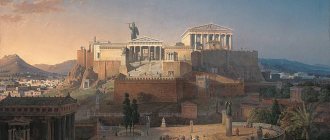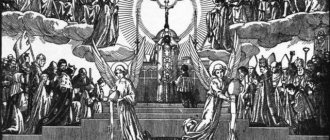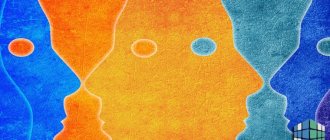Worldview is the way we perceive and understand reality.
These are our principles, attitudes, ideas about the things around us: society, nature, humanity.
A person's worldview can be compared to glasses. Some people look at the world through the prism of their life experience, others through the prism of religion.
Others question the very possibility of understanding the world around us.
The term was first used in the early 18th century in the works of German philosophers.
Synonyms : ideology, belief system, life credo.
The role of worldview in human life
For all people, without exception, worldview acts as a kind of beacon. It provides guidelines for almost everything: how to live, act, react to certain circumstances, what to strive for, what to consider true and what to consider false.
Worldview allows you to be confident that the goals set and achieved are important and significant both for the individual and for society as a whole. Depending on one or another worldview, the structure of the world and the events taking place in it are explained, the achievements of science, art, and people’s actions are evaluated.
Finally, the established worldview provides a person with peace of mind and confidence that everything is going as it should. Changing external events or internal beliefs can lead to an ideological crisis. This happened among representatives of the older generation during the collapse of the USSR. The only way to cope with the consequences of the “collapse of ideals” is to try to form new (legally and morally acceptable) worldviews. A specialist can help with this.
Functions of worldview
It can be said without exaggeration that worldview determines a person’s entire life, forcing him to choose one or another path for himself when making fateful decisions. Moreover, it has 3 main functions:
- Cognitive. Worldview is a source of knowledge. This knowledge is not necessarily reliable, but it allows you to quickly find answers to questions that arise.
- Value-oriented. As part of this function, worldview helps a person form his own value system.
- Practical. Every day we make hundreds of decisions in different areas of life, guided by our worldview.
Worldview, its types and forms
There are certain components of worldview:
- Knowledge
. They can be scientific, professional and practical. This is the first element of any worldview. The larger the circle of knowledge, the firmer the life position. - Feelings
. Types of worldview manifest themselves in accordance with a person’s subjective reaction to external stimuli. Depending on the mental state, the reaction can be either positive, associated with joy and pleasure, or negative, associated with sadness, grief, and fear. There is also a moral aspect - this is duty, responsibility. - Values
. The concept of worldview is closely related to values. They can be significant, useful and harmful, but they are perceived through the prism of one’s own goals, interests and needs. - Actions
– positive and negative. This is how a person shows his own views and ideas in practice. - Convictions
are strong, strong-willed. This is a set of personal and social views that are a kind of engine and basis of life. - Character
– will, faith, doubts. Based on the ability for independent and conscious action, self-confidence, trust in others and self-criticism, a worldview is formed and developed.
Philosophical worldview
It is defined as system-theoretical. It differs from the mythological worldview in the high role of reason: if myth uses emotions and feelings as support, then philosophy uses logic and evidence. This type of worldview studies the forces that rule the world. Philosophy and worldview emerged simultaneously in Ancient India, China and Greece. At the same time, a worldview can exist outside of philosophy, but philosophy itself forms a worldview. Philosophical knowledge is elitist and not accessible to everyone. Rarely do pundits get carried away by it.
Religious worldview
It arose from the mythological and is based on belief in supernatural forces. As religious movements developed, many mythological features faded into oblivion, but rigid dogmatism and a system of moral commandments remained. Worldview types that include piety and holiness imply dependence on higher powers. At the heart of this worldview is fear of the unknown. A holistic religious worldview was formed when indisputable systems of dogmas and commandments appeared that determined the sinfulness and holiness of certain thoughts and actions.
Mythological worldview
This type was formed in the conditions of primitive society, when it was based on a figurative perception of the world. Mythology is closely connected with paganism and acts as a set of myths, spiritualizing material objects and phenomena. This human worldview is mixed with the sacred and the profane, but at its core is faith. According to tradition, a follower of such a worldview is able to rise to the level of god, and all the existing myths were useful from a practical point of view and were a guide to action.
Scientific worldview
This worldview arose as the opposite of the mythological and religious. The scientific picture of the world is based on the concepts of law and regularity. The main types of worldview - mythological and religious - are based on fictitious, arbitrary and supernatural reasons, and science develops in the course of complicating work and solving practical problems. Such a progressive worldview provides an opportunity to draw new knowledge from previously acquired knowledge. Rationality, transferred to religion and mythology, gave impetus to the development of philosophy.
Everyday worldview
This attitude is formed by itself in each person and is the core of common sense. The peculiarities of the worldview lie in the fact that its development partly depends on genetic inheritance. In the course of upbringing by parents, communication with friends and loved ones, and contact with the environment, values, priorities and life attitudes are formed, which by puberty acquire the features of a very specific worldview. The characteristics of the native language and the degree of its assimilation, as well as labor and tool activity, are of utmost importance in this process.
Historical worldview
In history, the types of worldview remain the same - mythological, religious and philosophical. For those who are interested in what kind of worldview there is, it is worth saying that the first was a myth - a fictitious plot, a figment of the people's imagination. Religion is closely related to mythology: both of them presuppose the presence of a mythological system and provide for the basis of myths on faith. Philosophy acts as a special way of cognition, because what a worldview is is a theory or science that studies the fundamental principles of being and knowledge.
What about worldview types?
And finally, according to types, worldviews are divided into:
- Dogmatism. Our worldview is built on already existing dogmas, that is, rules and theories. For example, in a religious worldview, we take dogmas from religion and follow them. They guide our decisions and actions.
- Reasonable criticism. In this case, we understand that worldviews can change. We subject reality to reasonable doubt.
- Skepticism. This is the type of our thinking when we doubt the very possibility of knowing the world or that we correctly understand. It is constant thinking and reflection.
Read more about Dogmas and Life Values.
Levels of worldview
The concept of worldview contains three levels:
- The first is the everyday kind of thinking, emphasizing life experience, common sense, instinct and hunches. It includes the largest part of society.
- The second level is more specific. It includes a person's knowledge consisting of experience in various professions, science, politics and art.
- The third is the highest. He's more philosophical. He studies the development of a person’s mind on a spiritual level, analysis of his actions and search for the source of his problems. Mostly outstanding people and representatives of philosophical science reach this level.
Worldview is built through worldview. People have different percentages of positive and negative conceptualization, which form more accurate life positions in the human mind.
Positive thinking pulls a person towards the complication of historically established systems. It is based on the concept of the past, as the only subjective form of reality. Such understanding underlies the life of humanity on earth.
Negative thinking, on the contrary, attracts to simplify the established system. The essence of this type is that the past is time that has already passed, the present is preparation for the future, and the future is their subjective reality. Most individuals with negative thinking constitute the anti-system.
Worldview and its levels
There are two levels of worldview: rational-theoretical and life-practical.
Rational-theoretical level
This is the level at which our mind studied the acquired knowledge, analyzed it and came to certain conclusions.
At this level, a person’s worldview is a system of his concepts and conclusions .
Life-practical level
At this level, our worldview is based only on experience , on those beliefs that we have come to because we have lived them.
For example, life experience may suggest that if a person ignores rudeness, then his mood does not spoil. Therefore, his attitude in life may be politeness to others.
Worldview function
The worldview function of philosophy is considered one of the most important.
It reveals the ability of philosophy to act as the basis of a worldview, which is an integral, stable system of views about the world and the laws of its existence, about the phenomena and processes of nature and society that are important for maintaining the life of society and man. The worldview of an individual appears in the form of a set of feelings, knowledge and beliefs. A special role in a person’s worldview is played by ideas about the principles that determine his relationship to the world, society and himself.
A worldview in its form can be:
- mythological
- religious
- philosophical.
It depends on what basis it is based on - mythological, religious or philosophical ideas. The basis of the mythological worldview is made up of myths, that is, fantastic stories about the world order and the place of man in the system of the universe. This worldview comes from an artistic and emotional experience of the world or from social illusions. The religious worldview is the next stage in the development of people’s views on the world; unlike myth, religion does not confuse the earthly and the sacred.
Holders of such a worldview believe that the creative omnipotent force - God - is above nature and outside of nature. At the center of any religious worldview are ideas about higher values and ways to achieve them. It is based on faith that cannot tolerate doubt and makes a person’s views dependent on religious dogmas. In contrast, a philosophical worldview is able to be based on the results of people’s cognitive and practical activities. An important role in the system of modern philosophical worldview is played by the data of science, synthesized in ideas about the scientific picture of the world.
Often in modern conditions, the worldview of individual people simultaneously combines mythological, religious and scientific ideas. These ideas give specificity to the worldviews of specific people.
Worldview, worldview and worldview
In worldviews that differ in form and character, the intellectual and emotional-psychological experience of people is combined in a special way; they reflect people’s worldview, worldview and worldview in different ways.
Attitude is the emotional and psychological side of the worldview. It expresses the sensations, perceptions, and experiences of people.
In a worldview based on visual representations, the world appears in its reality, the images of which are mediated by a combination of emotional, psychological and cognitive experience of people.
Worldview is formed on the basis of attitude and worldview. As science develops, the nature of the worldview is increasingly influenced by the knowledge it acquires. The importance of worldview lies in the fact that it is the basis for the formation of a person’s needs and interests, his ideas about norms and values, and therefore his motives for activity. The development and improvement of worldview, worldview and understanding of the world leads to an increase in the quality of the content of the worldview and an increase in the power of its influence on living life.
As a system of beliefs, people’s worldview is formed on the basis of a wide variety of knowledge, but its final form is given by philosophy, which, as noted earlier, generalizes the attitudes contained in it and develops extremely general principles of both knowledge, understanding, and transformation of the world. The foundation of a worldview is information about normative formations that mediate its orientation and give it effectiveness.
Philosophy is a means of forming and justifying the content of the most general, fundamental and therefore essential normative formations of the worldview that mediate the entire life support system of people. In this sense, it is justified to consider it as the basis of a worldview that a person uses in his interactions with the world and to endow it with a worldview function.
The main purpose of philosophy
Only through the unity and combination of these functions does a distinctive feature of philosophical knowledge appear. The role of philosophy especially increases in transitional, unstable periods of social development, when the usual foundations of social existence undergo profound changes; in these difficult periods, when old values have disappeared and new ones have not yet formed, philosophy can help a person adapt to the new, talk about how to live in harmony with the world and with oneself - what can be called the spiritual and therapeutic role of philosophy.
The main form of existence of philosophy is the entire history of philosophical thought. Historical types of philosophy are distinguished in accordance with historical eras in the development of mankind. Each of them, introducing its own characteristics, changed the vector of interest of thinkers and raised philosophical questions to a new level of understanding.
Thus, philosophical knowledge is the first form of theoretical knowledge, it: has a complex structure, is extremely general in nature, includes not only objective knowledge about the world, but also the value-semantic attitude of a person to the world, bears the imprint of the personality of a certain philosopher, dynamically ( develops historically) and is inexhaustible in its essence.
The main purpose of philosophy is the elevation of man, providing universal conditions for his improvement. Aristotle wrote: “All sciences are more practical than philosophy, but none is better!”
The functions of philosophy are as follows: integrative, educational, worldview, methodological, critical, and so on.
Worldview structure
The meaning of a worldview consists of knowledge, rules, attitudes, principles and ideals. The human mind accepts its place in society, accepts itself and learns to live with external stimuli. A person gets acquainted with the world and navigates it with the help of information and established rules. With principles, she forms her place in society, creates her own values and determines her emotional attitude towards external stimuli. And with established ideals, a person develops, forms his character and moves up the moral and intellectual ladder.
Of course, the above does not fully describe the structure of the worldview. Such concepts are more objective (knowledge and information) and subjective (principles and ideals).
Beliefs occupy an important place in the structure of a worldview. They influence the behavior of the individual in society, in the choice of his priorities for self-realization in them
The primacy between the forms of structure can change both in one consciousness and in the mass consciousness.
Characteristic features of worldview
Both individual and social worldviews are characterized by the following features:
- Historical conditioning. A person’s worldview is formed on the basis of the worldview of the society in which he grew up. Thus, both the public and individual worldviews, as a rule, deeply contain the problems experienced by this society, various “historical traumas,” significant events, and so on.
- Relationship with beliefs. Each person has his own life principles and beliefs, and they are always closely interconnected with his worldview. As we age, some beliefs change, and this affects our worldview. Of course, there is also an inverse relationship. New knowledge and life experiences can influence worldview, and this affects beliefs.
- Dependence on emotions. Most people sincerely believe that their worldview does not in any way contradict the laws of logic and common sense. But in reality everything is somewhat different. Our worldview is formed primarily on the basis of an emotional assessment of various events that we experience ourselves or observe from the outside.
- Dependence on knowledge. Factual knowledge about the surrounding reality also has a significant impact on the worldview in the process of its formation and development. For example, it changes dramatically for people who study basic psychology as they begin to better understand other people's motives (and even their own).
- Possibility of active formation. In most cases, the worldview is formed passively, based on the most available information (books, television shows, serials, etc.). However, each person has the opportunity to independently seek new knowledge, making efforts to consciously shape their worldview and their individuality.
Hierarchical structure of worldview
Humanity continually accumulates knowledge, creating culture. Starting from childhood, a person forms an idea of the world under the influence of personal characteristics of perception, including upbringing, temperament, intelligence, local mentality, etc.
Worldview is a hierarchical structure of a person’s beliefs, consisting of many levels. At each step of this pyramid, beliefs have a relatively greater or lesser degree of confidence in a person. They can be presented in the form of a diagram, which is based on facts verified by personal experience; at a higher and less “solid” level there will be facts from the lives of familiar people, and the very top will be occupied only by theory, assumptions about the unknown sphere of the world.
Introduction
Each science is a kind of scrap of knowledge, and all sciences in simple addition are the sum of scraps. Philosophy provides a system of knowledge about the world as a whole. He does not simply add up all scientific knowledge, but integrates this knowledge, taking it in its most general form and, based on this integral, builds a system of knowledge about the world as a whole, about man’s relationship to the world, i.e. about reason, about knowledge, about morality, etc.
According to V.S. Solovyov, the task of philosophy is not one side of what exists, but everything that exists, the whole world in the fullness of its content and meaning; he strives not to determine the exact boundaries and external interactions between parts and particles of the world, but to understand their internal connection and unity.
In this regard, there is a need to define the subject of philosophy and its functions.
Worldview in psychology
The formation of a person’s views is mainly influenced by various factors: family, children. kindergarten, school, media, books, films, etc. In educational institutions for teenagers and young men, the worldview is built in a more dialectical-materialistic way. The essence of this submission is four rules:
– the world is material;
– everything that exists around us regardless of our consciousness;
– everything in the world is interconnected and develops according to specific laws;
– a person can and must obtain reliable knowledge about the universe.
At different ages, people perceive the world and information about it differently, therefore, in educational institutions, a worldview is formed at certain stages.
Preschool age marks the beginning of the formation of a worldview. The child learns to exist in the world. Initially, the baby sees the world holistically, then begins to identify the basics and distinguish between them. Communication with parents and peers develops a connection with the environment. In kindergartens they teach how to establish cause-and-effect relationships (why you need to dress warmly in winter) and find solutions to problems (how to find Cinderella using a lost shoe). Fiction plays the main role in creating a worldview at this stage of growth. In communicating with people, the child learns to form relationships and build behavior in order to comply with general rules.
At primary school age, children build a worldview both in and outside of class. Schoolchildren are active and independently obtain information from books, magazines and the Internet. With the help of an adult, the child can digest the information received and form an attitude towards it. In the primary grades, children are introduced to natural phenomena and the concept of social life at the level of ideas. This method lays the main foundation in personal opinion.
Adolescence is the time of developing one’s own worldview. A teenager builds contact with the world based on his own experiences and situations he has experienced. In secondary schools they begin to ask the question “What do you want to become?” The student more consciously seeks his place in society. Popular ways to develop a worldview are to perform laboratory work, conduct conversations, discussions, lectures, and various excursions. As soon as a teenager begins to distinguish between good and bad with internal emotions, he begins to grow up.
At the adolescent stage of an individual’s age-related changes, the ways of developing a worldview remain almost the same as in adolescence: school lessons, lectures, communication in social groups, etc. But they are also supplemented by classes in sports clubs, lectures of a more narrow profile, reading books, watching films, pre-conscription training and service in the armed forces. The highlight of adolescent development is that girls and boys try to accept their lives as an integral, logical chain that makes sense. But the complexity of adolescence is reflected in the desire of young people to benefit society and satisfy their own aspirations. Subsequently, the difficulty of choosing between reality and needs can lead to psychological problems.
An adult’s worldview develops during work, self-education, self-education and life circumstances.
In the end, I would like to say that a person’s worldview is an entire universe. Thanks to different principles, ideals and subjective values, people discover something new in each other every day. The transformation of his mind and spirit transforms the personality into an individual.
Components of a worldview
Worldview is usually divided into three components:
- Attitude. This is the emotional component of the worldview. When interacting with the world around us, a person evaluates the events taking place, and he develops an understanding of how fair the world is to him and in general. Some people rejoice at good luck and anticipate success, while others experience the opposite feelings. Thus, according to their worldview, people are divided into pessimists, who believe the world is unfair, and optimists, who believe that the world is favorable to them.
- Worldview. This component is similar to the previous one. A person can consider the world friendly or hostile, and based on this build his picture of the world. Worldview determines how a person sees others and how he positions himself. He may consider himself a winner or a loser, and those around him as friends or enemies.
- Worldview. This component characterizes the level of knowledge of the surrounding world and is determined by the complexity of the images that a person can operate with. As you grow older, your worldview expands. Immediately after birth, the child perceives only the image of the mother, but later learns to perceive other people as well. Over time, the worldview expands to a city, country, planet, universe.
Worldview of modern man
Unfortunately, in modern society there is a crisis in its spiritual sphere. Moral guidelines (duty, responsibility, mutual assistance, altruism, etc.) have lost their meaning. Receiving pleasure and consumption come first. In some countries, drugs and prostitution have been legalized, and the number of suicides is growing. Gradually, a different attitude towards marriage and family, new views on raising children are being formed. Having satisfied their material needs, people do not know what to do next. Life is like a train, in which the main thing is to get comfortable, but where and why to go is unclear.
Modern man lives in an era of globalization, when the importance of national culture is declining and alienation from its values is observed. An individual becomes, as it were, a citizen of the world, but at the same time loses his own roots, connection with his native land, members of his clan. At the same time, contradictions and armed conflicts based on national, cultural and religious differences do not disappear in the world.
Throughout the 20th century, people had a consumerist attitude towards natural resources and did not always wisely implement projects to change biocenoses, which subsequently led to an environmental disaster. This continues today. The environmental problem is one of the global problems.
At the same time, a significant number of people realize the importance of change, searching for life guidelines, ways to achieve harmony with other members of society, nature and themselves. Promoting a humanistic worldview, focusing on the individual and his needs, revealing a person’s individuality, and establishing friendly relationships with other people is becoming popular.
Instead of an anthropocentric type of consciousness (man is the crown of nature, which means he can use everything it gives with impunity), an ecocentric type begins to form (man is not the king of nature, but a part of it, and therefore must treat other living organisms with care). People visit temples, create charities and environmental protection programs.
A humanistic worldview presupposes a person’s awareness of himself as the master of his life, who must create himself and the world around him, and bear responsibility for his actions.
Therefore, much attention is paid to nurturing the creative activity of the younger generation.
The worldview of modern man is in its infancy and is characterized by inconsistency. People are forced to choose between permissiveness and responsibility, consumerism and concern for others, globalization and patriotism, the approach of a global catastrophe or the search for ways to achieve harmony with the world. The future of all humanity depends on the choices made.
Subject of philosophy. The place of philosophy in the system of sciences and culture
The term philosophy comes from the combination of two Greek words phileo - love and sophia - wisdom and means love of wisdom.
Philosophy as a method and form of spiritual activity originated in India and China, but reached its classical form in Ancient Greece. The term philosophy was first used by Plato to designate a special field of knowledge. At first, philosophy included all knowledge about the world.
The growing need to obtain knowledge and the expansion of the scope of its application in practice stimulated an increase in its volume and diversity and led to the differentiation of knowledge, expressed in the emergence of various sciences. The decomposition of unified knowledge into separate sciences, which began in the period of antiquity, did not mean the disappearance of philosophy. On the contrary, there is a need for a special section of knowledge that could act as a means of integrating knowledge and a way to develop the most general principles and norms of cognitive and transformative activity of people. Gradually, philosophy focused its attention on theorizing the most general ideological problems of nature, society and thinking, trying to provide answers to questions about the goals and meaning of the existence of society and the individual. It is impossible to give answers to these questions, which arise in historically specific conditions of life, suitable for all times and for all peoples. People asking worldview questions sought to get answers that corresponded to their needs and level of intellectual development. Moreover, in different historical conditions, not only the set of ideological questions changes, but also their very hierarchy, as well as the nature of the desired answers to them, is transformed. This lays the foundation for the specific understanding of the subject of philosophy and its content.
It should be noted that for a long time the subject of philosophy was identified by many scientists with the subject of science as a whole, and the knowledge contained within certain sciences was considered as components of philosophy. This situation continued until the 18th century. However, in the foreground of philosophizing, various thinkers highlighted those facets of the subject of philosophy that were of primary interest to them. Often individual thinkers limited the subject of philosophical study to only a few that seemed to them the most important. In other words, it should be borne in mind that the subject of philosophy, as well as ideas about it, is formed with the development of scientific knowledge, that is, information about it is formed in the process of transformation of philosophy itself. For example, from the history of philosophy we know that the natural world was the subject of philosophy for the first ancient Greek philosophers, and later for Aristotle the whole world acted in this capacity. For the Epicureans and the later Stoics, the subject of philosophy is mainly delineated by the range of problems associated with man in the world. Christian philosophers of the Middle Ages reduced the subject of philosophy to the relationship between man and God. In modern times, problems of cognition and methodology come to the fore in the structure of the subject of philosophy. In the Age of Enlightenment, for many European philosophers, the subject of reflection again becomes a person with all his many relationships. In the nineteenth and twentieth centuries. the variety of schools and ideas in world philosophy corresponds to the richness of ideas about the nature of its subject. Currently, the subject of philosophical reflection is the natural and social world, as well as man in it as a multidimensional and multi-level system in all its abundance of connections. Philosophy studies the most general aspects, properties, trends in the development of the world, reveals the general principles of self-organization, the existence and development of the nature of society, man and his thinking, reveals the goals and meaning of human existence in the world. At the same time, modern philosophy bases its conclusions on a generalization of data from individual sciences.
The subject of philosophy also includes consideration of questions about how philosophy itself arises, develops and transforms, how it interacts with various forms of social consciousness and practice.
In other words, the entire set of the most general questions concerning the relationship between man and the world is considered as a subject of philosophy, the answer to which allows a person to optimize the realization of his needs and interests.
Historical types of worldview
Throughout their lives on the planet, people continue to discover something new in different industries, even when the teachings officially cease. Such knowledge can be ordinary, religious and scientific. But these are not all the species that represent the worldview of people.
The main types of worldview include mythological, religious and philosophical.
The mythological type helped explain phenomena in nature that people could not explain. This is how myths appeared in which fantastic events exceeded reasonable ones (causes of fatal diseases, rain, snow, floods, etc.) With legends, people formed general concepts of good and bad, darkness and light. Therefore, mythological explanation plays an important role in the worldview of society.
The religious type of worldview contains specific rules for moral existence on earth, calls for a healthy lifestyle and faith in the charter without explanation. It unites society, but also divides members of other religious groups.
The philosophical type represents greater freedom of mind, and not emotional, as in the mythological type. Here the right to perceive the world is given to the human mind, without religious restrictions. And the individual feels free-thinking.
Recently, scientists have identified slightly different types of worldview: scientific, everyday and humanistic.
Scientific knowledge is presented on the basis of conclusions and accurate evidence. For example, the Earth is round, etc.
Ordinary knowledge consists of the experience and conclusions of one individual from its life. For example, after cutting yourself with a knife, a person understands how to use it more carefully.
The humanistic concept calls for accepting a person with his ideals and life positions. Do not subject an individual to humiliation in society due to differing opinions. But this tactic is not followed everywhere.
Example of worldview
As we have already discussed, worldview is a system of views and assessments about the world around us, people, and ourselves. Of course, the worldview is very multifaceted and concerns many aspects of life, but as an example, let’s go through the most important aspects. So, an example of a worldview:
The world around us exists according to certain laws, some of which are fair, others not quite. On the one hand, if you work and put in the effort, then everyone can achieve success. This is true. However, not everyone has equal opportunities. Due to health problems, some people have a much harder time from birth. It's not fair. But it’s impossible to change this, so all I have to do is accept these rules and try to do what I can with what I have. However, whenever possible, I believe it is necessary to help people who need it, trying to make the world a little better.
There is nothing supernatural in the world - everything functions according to rules that are explainable from the point of view of science. Science has already been able to explain much of what is happening around us, but much remains to be studied. For me, studying the world around me is of great interest; I love to comprehend the secrets of space and never cease to be amazed at the immense size of the universe.
People are divided into good and bad. Understanding who is in front of you is often difficult, and sometimes even impossible. But everything secret becomes clear - sooner or later every person reveals his true essence. Because of this, I am in no hurry to trust and open up to people until it becomes clear to me for sure that the person can be trusted.
I am a good person, but not perfect. I consider qualities such as honesty, integrity, and the ability to keep one’s promises to be among the most important qualities of a person. I try to cultivate and maintain these qualities in myself. Meanwhile, I also have a number of disadvantages, which include the desire to criticize others, teach without asking, and interfere with my advice left and right. This quality complicates my relationships with others, so I try to restrain myself.
I consider it inappropriate to search for what the meaning of life is, since you cannot find a single answer to this question, no matter how much you search. However, the lack of meaning does not make life worse. The only thing that matters is whether I am happy or not. If yes, then I'm on the right track. If not, then you need to change something in life, try something new. The main thing is to remember that every day is beautiful and unique in its own way. Every day deserves a chance to be the best you can be in life.
This example contains only a small part of what is included in the concept of worldview. The text could be continued for a long time, but you got the main idea. In simple terms, worldview is an attitude towards everything that is around and an awareness of one’s place in this world.
Large psychological dictionary online
We also provide our clients with a wide range of psychological services - psychological counseling, psychotherapy, psychodiagnostics, psychotraining, transformation games, etc. for both individuals and organizations.
We also invite you to our new website mvya.ru
☏ Tel. Viber and WhatsApp: +7 (985) 920-07-50. You can get advice from a psychologist, wherever you are, with the service of our Center, psychologist help via Skype.
| Large dictionary of psychology, best psychological dictionary and meanings of psychological terms |
Welcome to the psychological dictionary, and we also offer a new service - free consultation and assistance for pensioners! Free visit to a psychologist for university students!
Main branches of philosophy
Within the framework of philosophical knowledge proper, its differentiation began already in the early stages of its formation, as a result of which such philosophical disciplines as ethics, logic, aesthetics arose, and the following sections of philosophical knowledge gradually formed:
- ontology - the doctrine of existence, the origin of all things, the criteria of existence, general principles and laws of existence;
- epistemology is a branch of philosophy that studies the problems of the nature of knowledge and its capabilities, the relationship of knowledge to reality, identifying the conditions for the reliability and truth of knowledge;
- axiology - the doctrine of the nature and structure of values, their place in reality, the relationship of values;
- praxeology - the doctrine of practical relations between man and the world, the activity of our spirit, goal setting and human effectiveness;
- anthropology - the philosophical study of man;
- social philosophy is a section of philosophy that describes the characteristics of society, its dynamics and prospects, the logic of social processes, the meaning and purpose of human history.
These sections are not reducible to each other, but are closely related.
Concept of worldview
Briefly, a worldview can be defined as a system of views on the surrounding reality, nature, society, and one’s place in the world that has developed in the process of life. Everything a person encounters causes him to react in a certain way. This inner response is made possible by worldview.
If we talk about what shapes a person’s worldview in a person’s life, we can list the following factors:
- family;
- Friends;
- society as a whole;
- level of development of science and technology;
- education;
- occupation;
- self-development, self-education and self-discipline.
Rice.
1. Student. The first six points can be attributed to external sources of worldview formation, the last - to internal ones. Often, for a person who is interested in self-development and is able to take responsibility for his own life, internal motivation comes first.
Question 1: worldview, its structure and functions
Question 1: worldview, its structure and functions
Worldview is a system of a person’s stable views on the world and his place in it. The broad meaning is all views, the narrow meaning is objective (within the corresponding form of worldview: mythology, religion, science, etc.). The term “worldview” supposedly appeared in the 18th century and has been popular since the 19th century.
Features of a worldview: active knowledge (position-action), integrity, universality (implies the presence of one or another worldview in every person).
The subject is relationships in the world-person .
The structure of a worldview – elements and connections between them. Levels of worldview structure:
- everyday-practical (“attitude”, “emotionally colored vision of the world”, “everyday worldview” of each person);
— rational-theoretical (“worldview”, “intellectual worldview”, uses concepts, categories, theories, concepts).
Structural elements: knowledge , values , ideals, action programs, beliefs (by which the authors mean not “firm principles”, but “accepted” - “knowledge and values” more or less approved by scientists), etc.
Functions of worldview : 1) axiological (value) and 2) orientation .
Historical types of worldview:
- mythological worldview (fantasies predominate, unity with nature, anthropomorphism, many supernatural forces, dominance of feelings);
- religious worldview (monotheism): psychological structure (feelings and actions of people, rituals) + ideological structure (dogmas, scriptures): the world is doubled (meaning, first of all, the Christian worlds of this and other worlds), God is spiritual, He is the creator outside world, Holy Scripture is the source of knowledge, hierarchy descending from God;
- philosophical worldview (free intellectual search for truth): understanding the ultimate foundations of being and thinking, justification of values, striving for integrity, logical argumentation), reliance on reason.
ADDENDUM: The above answer is quite suitable for answering question No. 1 of the Approximate list of questions for the entrance exam to graduate school at the Belarusian State University: “Worldview, its essence, structure and historical types.”
Question. 2 historical types of worldview levels and structure
Worldview structure
Worldview is a synthesis of various features of a person’s spiritual life; This is a person’s knowledge and experience of the world. The emotional and psychological side of the worldview at the level of moods and feelings is the worldview. For example, some people have an optimistic outlook, others have a pessimistic one. The cognitive-intellectual side of the worldview is a worldview.
Worldview, like the whole life of people in society, has a historical character. The emergence of a worldview is associated with the process of formation of the first stable form of human community - the tribal community. Its appearance became a kind of revolution in the spiritual development of man. Worldview distinguished man from the animal world. The history of the spiritual development of mankind knows several basic types of worldview. These include mythological, religious, philosophical worldview.
Historically, the first stage in the development of a worldview was the mythological worldview. Mythology consolidated the system of values accepted in society, supported and encouraged certain forms of behavior. With the extinction of primitive forms of social life, myth became obsolete and ceased to be the dominant type of worldview.
The fundamental questions of every worldview (the origin of the world, man, the mystery of birth and death, etc.) continued to be resolved, but in other ideological forms, for example, in the forms of a religious worldview based on belief in the existence of supernatural beings and a supernatural world, and a philosophical worldview that exists as a theoretically formulated system of the most general views on the world, man and their relationships.
Each historical type of worldview has material, social and theoretical-cognitive prerequisites. It represents a relatively holistic ideological reflection of the world, determined by the level of development of society. The features of various historical types of worldviews are preserved in the mass consciousness of modern people.
Worldview is a complex, synthetic, integral formation of public and individual consciousness. Essential for its characteristics is the proportional presence of various components - knowledge, convictions, beliefs, moods, aspirations, hopes, values, norms, ideals, etc. In the structure of the worldview, four main components can be distinguished:
1. Cognitive component. It is based on generalized knowledge - everyday, professional, scientific, etc. It represents a specific scientific and universal picture of the world, systematizing and generalizing the results of individual and social knowledge, the thinking styles of a particular community, people or era.
2. Value-normative component. Value is the ability of some object or phenomenon to satisfy the needs and desires of people. The human value system includes ideas about good and evil, happiness and unhappiness, purpose and meaning of life. A person’s value attitude towards the world and towards himself is formed into a certain hierarchy of values, at the top of which are the absolute values fixed in social ideals. The consequence of a person’s stable, repeated assessment of his relationships with other people are social norms: moral, religious, legal, etc. that regulate the daily life of both an individual and the entire society. In them, to a greater extent than in values, there is a commanding, obliging element, a requirement to act in a certain way. Norms are the means that bring together what is valuable for a person with his practical behavior.
3. Emotional-volitional component. In order for knowledge, values and norms to be realized in practical actions and actions, it is necessary to assimilate them emotionally and volitionally, transform them into personal views, convictions, and also develop a certain psychological attitude towards readiness to act. The formation of this attitude is carried out in the emotional-volitional component of the worldview component.
4. Practical component.
Worldview is also a person’s real readiness for a certain type of behavior in specific circumstances. Even if this worldview orients a person not towards participation in life, but towards a contemplative position, it still projects a certain type of behavior. Based on the above, we can define a worldview as a set of views, assessments, norms and attitudes that determine a person’s attitude to the world and act as guidelines and regulators of his behavior. Question.
3 The main question of philosophy and its 2 sides The question of the relationship between matter and consciousness, i.e. essentially about the relationship of the world
and man is the fundamental question of philosophy. The main question has 2 of its own
sides.
1. What comes first, consciousness or matter?
2. How do our thoughts about the world relate to this world itself, i.e. do we know the world?
From the point of view of revealing the 1st side of the main question of philosophy in the system
General philosophical knowledge is distinguished by the following areas: a) materialism; b)
idealism; c) dualism.
Materialism is a philosophical movement that asserts the primacy of matter and
secondary consciousness. Idealism is a philosophical movement that asserts
the opposite of materialism. Dualism is a philosophical school that argues that
matter and consciousness develop independently of each other and go in parallel.
(Dualism did not stand up to the criticism of time) Variations of Materialism and Idealism
(Forms of materialism and idealism)
1. Naive materialism of the ancients (Heraclitus, Thales, Anaximenes, Democritus) Essence:
Matter is primary.
This matter meant material states and physical
phenomena that, upon simple observation, were found to be global, without
attempts at scientific substantiation, simply as a result of ordinary observation of
environment at the level of naive explanation. They claimed that massively
what exists around people is the origin of everything. (Heraclitus - fire, Thales -
water, Anaximenes - air, Democritus - atoms and emptiness.)
2. Metaphysical - matter is primary to consciousness. Specificity of consciousness
was ignored. The extreme version of metaphysical materialism is vulgar.
“The human brain secretes thoughts the same way the liver secretes bile.”
Metaphysical materialists of the late 18th century - Diderot, Mametrie, Helvetsky.
3. Dialectical materialism (Marx and Engels)
Essence: Matter is primary, consciousness is secondary, but the primacy of matter is
relation to consciousness is limited by the framework of the main philosophical question.
Consciousness is derived from matter, but, having arisen in matter, in turn
can significantly influence and transform it, i.e. between matter and
consciousness there is a dialectical relationship.
Types of Idealism:
1. Objective - independent of human consciousness.
The essence: the primary idea of consciousness, which is objective: Plato - the world and the day, the idea,
memory. Hegel is an absolute idea.
2. Subjective idealism (Berkeley, Mach, Hume). Essence: The world is a complex of my sensations.
Philosophy of Socrates
SOCRATES. 469 –399 BC e. Born into a poor Athenian family - a stonemason. A supporter of the Athenian aristocracy. An opponent of the Sophists, he criticized politicians for their unsuccessful struggle against Sparta. The court declared him disrespectful of the Gods for criticizing the selection of officials by drawing lots. Sentenced to death. Socrates believed that the structure of the world, physics. the nature of things is unknowable; we can only know ourselves (“Know thyself”). The highest task of knowledge is not theoretical, but practical. - ability to live. He used the following methods: question-and-answer, induction, maeutics (a form of conversation in which the ability to conduct a dialogue meant the ability to ask leading questions), irony. He considered the main task in philosophy to be the rational justification of a moral and religious worldview, and the study of nature was fundamentally impossible. He considered the soul principle to be the basis of the world. The most important task is to know oneself and emphasize the importance of conscience. Conscience is of divine origin. The gods use it to distinguish man from animals. The goal of everything in the world is man. For Socrates, morality merges with consciousness. True morality is the knowledge of what is good, beautiful and at the same time useful for a person. It helps to achieve bliss and happiness in life. Basic virtues: 1. Restraint (how to tame passions)2. Courage (how to overcome danger)3. Justice (how to observe divine and human laws)
Socrates (469–399 BC) did not write anything, was a sage close to the people, philosophized in the streets and squares, entered into philosophical disputes everywhere: we are known as one of the founders of dialectics in the sense of finding truth through conversations and disputes ; developed the principles of rationalism in matters of ethics, arguing that virtue comes from knowledge and a person who knows what good is will not act badly.
Philosophy of the era of scholasticism
Scholasticism (from the Latin schola - school) arises as a rationalization of Christian doctrine. The goal of scholasticism is to streamline dogmatics and make it easy to understand for “simple people” (illiterate people). Philosophy was recognized as the main means of streamlining Christian dogma for the following reasons:
• with the help of reason it is easier to penetrate the truths of faith;
• using philosophical arguments, you can avoid criticism of holy truths;
• with the help of philosophy, it is possible to give religious truths a systematic form and create a completely demonstrative system of philosophical doctrine.
The ancient sources of scholastic thought are the Neoplatonic tradition, Augustine, Boethius. Later, the “rediscovered”, newly read works of Aristotle became normative.
Early scholasticism is associated with a revival of interest in knowledge. Thinking at this time was characterized by greater independence in posing questions.
Among the main problems of early scholasticism were the following:
• relations of faith and knowledge;
• the problem of universals;
• coordination of Aristotelian logic and other forms of knowledge;
• coordination of mysticism and religious experience.
The most famous thinker of early scholasticism is Anselm , Archbishop of Canterbury (1033-1109). According to Anselm, true thinking cannot contradict faith. The truths of faith are justified by natural reason. Faith, however, must precede reason. Anselm has an ontological proof of the existence of God .
Interest in the work of Boethius sparked the debate about universals . Do universal definitions, i.e. genera and species, correspond to reality in itself or do they exist only in thinking? This dispute led to the spread of the scholastic method and became the main topic of philosophizing for several centuries. Ultimately, three points of view were expressed in the discussion:
• extreme realism , which argued (thus continuing Plato's line of philosophizing) that universals, i.e. genera and species, exist before things, as real entities;
• extreme nominalism (from the Latin nomen - name), which insisted (going back to the Stoic tradition) that the genera and ides exist after things, as common names;
• moderate realism , which was based on the Aristotelian tradition - genera and species exist in the things themselves.
The rise of scholasticism (13th century) is associated with the emergence of universities. The creation and development of these higher educational institutions and the existence of qualified teachers led to the appearance of large systematic works.
The image of high scholasticism is formed by the reception (borrowing and adaptation) of Aristotle’s works, which occurred thanks to a new acquaintance with his texts through translations from Arabic, and then directly from Greek. The works of Aristotle, together with Arabic works about the philosopher himself, as well as commentaries on his works, are included in university circulation. The Arab Neoplatonic reception of Aristotle himself and the Neoplatonist provisions of the works attributed to Aristotle led to a pantheistic perception of the scientist. Church authorities opposed this understanding of Aristotle, even to the point of prohibiting reading and commenting on his works. But no thinker could do without the founder of new knowledge, Aristotle. Thus, the development of high scholasticism about. In this dispute, members of the Catholic orders , Augustian-oriented Franciscans Dominicans . In addition, in the scholastic tradition, the development of Neoplatonic, natural science and logical directions should be noted.
Merged together, Aristotelianism, Neoplatonism and Augustianism became the basis of the teachings of the great taxonomist of the Middle Ages, Thomas Aquinas (1225-1274), who made an influential attempt to streamline the connection between Aristotelianism and Christian philosophy.
Thomas gave his own answer to the question of the relationship between faith and reason. Faith and reason cannot contradict each other, since both come from God. Theology (theology) and philosophy cannot come to different conclusions. They differ, however, in their approaches: philosophy goes to God from created things, theology from God to the created world. God's revelation communicates to people only those truths that are necessary for their salvation. Consequently, there remains room for independent exploration of things that are not explained by revelation. Philosophy masters this space, providing and defending the foundations of faith.
The main idea of Thomistic (from the Latin Thomas - Thomas) ontology is the complete order of all being . Every being is given by God its position and its purpose in the order of being is determined. Everything created is characterized by a difference of being and essence. Only in God does his being coincide with his essence.
The era of late scholasticism can be described as the era of the decline of medieval philosophizing. Nominalism criticized the metaphysical systems of the old schools, but did not provide new ideas. In the debate about the nature of general concepts, the old schools defended the position of moderate realism. They were represented by both the late Thomists (followers of the teachings of Thomas Aquinas) and the school of Johann Duns Scotus (c. 1266-1308). Nominalism came to the idea of removing the synthesis of faith and knowledge. The English philosopher and ecclesiastical-political writer William of Ockham (c. 1285-1349) suggested that the subject of real sciences is not the things themselves, but the terms of propositions as representatives of things.
The development of nominalism was accompanied by the flourishing of natural science, especially in Paris and Oxford. In addition, it should be noted that the development of scholasticism does not stop there. Despite the fact that modern European scholasticism increasingly lost the continuity of tradition, it continued to be developed during the 16th and 17th centuries, especially in Spain and Italy, as a reaction to the Reformation and the Renaissance. In the 19th century so-called neoscholasticism .
Question. 11. Main directions and characteristic features of Renaissance philosophy
1. General concept and premises of Renaissance philosophy.
The philosophy of the Renaissance is a set of philosophical trends that arose and developed in Europe in the 14th – 17th centuries, which were united by an anti-church and anti-scholastic orientation, a focus on man, faith in his great physical and spiritual potential, life-affirming and optimistic character.
The prerequisites for the emergence of Renaissance philosophy and culture were:
improvement of tools and production relations;
crisis of feudalism;
development of crafts and trade;
strengthening cities, turning them into trade, craft, military, cultural and political centers, independent of feudal lords and the Church;
strengthening, centralization of European states, strengthening of secular power;
the emergence of the first parliaments;
lag behind life, crisis of the Church and scholastic (church) philosophy;
increasing the level of education in Europe as a whole;
great geographical discoveries (Columba, Vasco da Gama, Magellan);
scientific and technical discoveries (invention of gunpowder, firearms, machine tools, blast furnaces, microscope, telescope, printing, discoveries in the field of medicine and astronomy, other scientific and technical achievements).
2. The main directions of philosophy of the Renaissance.
The main directions of philosophy of the Renaissance were:
humanistic (XIV - XV centuries, representatives: Dante Alighieri, Francesco Petrarca, Lorenzo Valli, etc.) - put the person in the center of attention, glorified his dignity, greatness and power, ironized the dogmas of the Church;
Neoplatonic (mid-15th - 16th centuries), whose representatives - Nicholas of Cusa, Pico della Mirandola, Paracelsus and others - developed the teachings of Plato, tried to understand nature, the Cosmos and man from the point of view of idealism;
natural philosophy (XVI - early XVII centuries), to which Nicolaus Copernicus, Giordano Bruno, Galileo Galilei and others belonged, who tried to debunk a number of provisions of the teachings of the Church and God, the Universe, Cosmos and the foundations of the universe, relying on astronomical and scientific discoveries;
reformation (XVI - XVII centuries), whose representatives - Martin Luther, Thomas Montzer, John Calvin, John Usenleaf, Erasmus of Rotterdam and others - sought to radically revise church ideology and the relationship between believers and the Church;
political (XV - XVI centuries, Nicolo Machiavelli) - studied the problems of government, the behavior of rulers;
utopian-socialist (XV - XVII centuries, representatives - Thomas More, Tommaso Campanella, etc.) - looked for ideal-fantastic forms of building a society and state, based on the absence of private property and universal equalization, total regulation by state power.
3. Characteristic features of Renaissance philosophy include:
anthropocentrism and humanism - the predominance of interest in man, belief in his limitless capabilities and dignity;
opposition to the Church and church ideology (that is, the denial not of religion itself, of God, but of an organization that has made itself a mediator between God and believers, as well as a frozen dogmatic philosophy serving the interests of the Church - scholasticism);
moving the main interest from the form of the idea to its content;
a fundamentally new, scientific-materialistic understanding of the surrounding world (spherical, not flat, Earth, rotation of the Earth around the Sun, and not vice versa, infinity of the Universe, new anatomical knowledge, etc.);
great interest in social problems, society and the state;
the triumph of individualism;
widespread dissemination of the idea of social equality.
Question 1: worldview, its structure and functions
Worldview is a system of a person’s stable views on the world and his place in it. The broad meaning is all views, the narrow meaning is objective (within the corresponding form of worldview: mythology, religion, science, etc.). The term “worldview” supposedly appeared in the 18th century and has been popular since the 19th century.
Features of a worldview: active knowledge (position-action), integrity, universality (implies the presence of one or another worldview in every person).
The subject is relationships in the world-person .
The structure of a worldview – elements and connections between them. Levels of worldview structure:
- everyday-practical (“attitude”, “emotionally colored vision of the world”, “everyday worldview” of each person);
— rational-theoretical (“worldview”, “intellectual worldview”, uses concepts, categories, theories, concepts).
Structural elements: knowledge , values , ideals, action programs, beliefs (by which the authors mean not “firm principles”, but “accepted” - “knowledge and values” more or less approved by scientists), etc.
Functions of worldview : 1) axiological (value) and 2) orientation .
Historical types of worldview:
- mythological worldview (fantasies predominate, unity with nature, anthropomorphism, many supernatural forces, dominance of feelings);
- religious worldview (monotheism): psychological structure (feelings and actions of people, rituals) + ideological structure (dogmas, scriptures): the world is doubled (meaning, first of all, the Christian worlds of this and other worlds), God is spiritual, He is the creator outside world, Holy Scripture is the source of knowledge, hierarchy descending from God;
- philosophical worldview (free intellectual search for truth): understanding the ultimate foundations of being and thinking, justification of values, striving for integrity, logical argumentation), reliance on reason.
ADDENDUM: The above answer is quite suitable for answering question No. 1 of the Approximate list of questions for the entrance exam to graduate school at the Belarusian State University: “Worldview, its essence, structure and historical types.”










